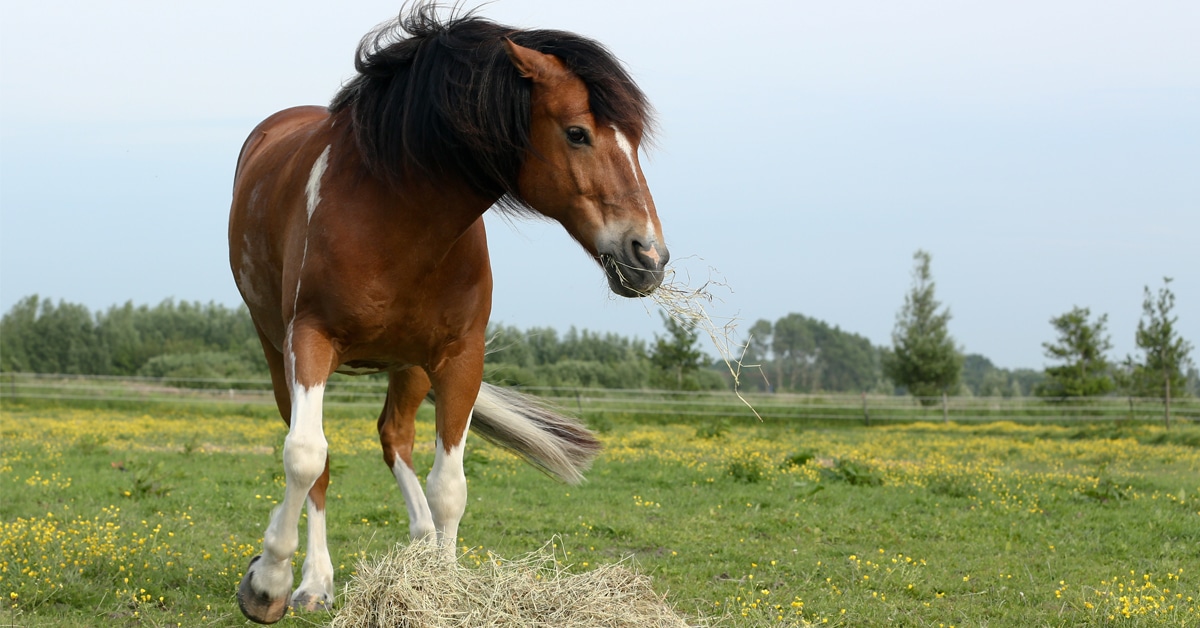1. HEMLOCK
Water hemlock (Cicuta maculata) is found in boggy areas throughout Canada. It has tiny green and white flowers that grow in umbels (umbrella-shaped clusters), and its leaves look similar to those of dill. A highly toxic yellowish oil can be seen when the stem is cut.
Members of this genus are considered the most deadly of all plants. One mouthful can kill an animal within 15 minutes, and horses may go into convulsions and die within minutes of consuming the most toxic parts of this plant – the roots, young leaves, and stems.
Almost as deadly as water hemlock is poison hemlock (Conium maculatum L.), found throughout southern Canada and the United States. Poison hemlock has a fernlike appearance, growing up to ten feet tall. Its lacy, triangular leaves resemble those of the carrot, and it has a musky odour, like that of a parsnip, when crushed. Poison hemlock is a biennial with small white flowers clustered in flat-topped umbels. Signs of poisoning are bloating, nervousness, trembling, pupil dilation, weakened heartbeat, cold extremities, paralysis, coma, respiratory failure, and even death. There is no specific antidote, and supportive care (stall rest, intravenous fluids, etc.) should be given as needed.
Poison hemlock and water hemlock should be removed from all areas where horses are kept.
2. NIGHTSHADE
All nightshades, which are members of the genus Solanum (flowering plants that include the potato and the tomato) should be considered poisonous. Eight varieties occur in Canada, of which only horsenettle or ball nettle, found in southern Ontario, are native.
The most familiar nightshade found across Canada is S. dulcamara (climbing nightshade or European bittersweet). Climbing nightshade is an attractive vine with purple or blue flowers and glossy, poisonous red berries.
Common nightshade (Solanum americanum) is an annual with translucent, pointed oval leaves. It has white to purplish drooping star-shaped flowers with five petals and five stamens. The fruits are small, shiny black berries. Common nightshade can occur along fencerows, in neglected areas and disturbed soils, and among grain crops. Horses that ingest it will show signs of neurological and gastrointestinal disorder, fatigue, muscle twitching, bloating, and congestion in the lungs, heart, and spleen. There is no treatment for nightshade poisoning other than supportive care.
3. ST. JOHN’S WORT
St. John’s wort (Hypericum perforatum L.) is a common agricultural weed in the eastern and western parts of Canada, but rare in the prairie regions. It is a perennial with clustered woody stems. The leathery leaves grow opposite one another and have tiny black dots that look translucent when held to the light. Bright yellow, one-inch flowers with prominent stamens grow in clumps. The fruit is a three-chambered capsule about 1/4 inch long.
New growth is as toxic as the mature plants and is most attractive to grazing animals. The toxin can cause blindness and photosensitivity if the animal is not removed from the sun. Elevated temperature, increased heartbeat, diarrhea, and sensitivity to cold water are other symptoms of St. John’s wort poisoning. Your veterinarian may treat with corticosteroids and broad-spectrum antibiotics.
4. HOARY ALYSSUM
The invasive weed hoary alyssum (Berteroa incana (L.) DC.) is an annual, winter annual, or short-lived perennial that grows only from seed. While it doesn’t appear to be toxic to cattle and sheep, in horses it can cause depression, stocking up, fever, diarrhea, intravascular haemolysis, and hypovolemic shock. Mortality in horses has been associated with hay containing 30-70% hoary alyssum. Both green and dried plants can remain toxic in contaminated hay for up to nine months.
Hoary alyssum has a greyish-green “hoary” appearance caused by a mix of star-shaped and simple hairs that cover the stems, leaves, sepals, and seedpods. Shoots are usually green to purplish in colour and highly branched. The clustering flowers are small (3mm across), with four white petals, each with a deep cleft at the apex. Seedpods are stalked, having a characteristic beak-like tip.
To date, hoary alyssum has been reported in all Canadian provinces except Newfoundland and Prince Edward Island. Because of its low water requirements, ability to grow in poor soils, deep taproot, woody stem, absence of natural enemies and abundant seed production, hoary alyssum can establish quickly to out-compete native flowering plants and grasses.
Maintaining healthy stands of vegetation and reseeding after major disturbances seem to be the best ways to prevent establishment of hoary alyssum.
5. MILKWEED
The 36 milkweed species (Asclepias) are named for the milk-like substance they release when cut. Leaves are stiff and are arranged in whorls or in opposite pairs. Small five-petaled flowers grow in club-like formations, forming rounded tops on thick green stems. The flowers are usually white, but can also be pink or orange. The seeds bear silky white hairs that aid in wind distribution and propagation.
Milkweed is widespread in Canada, growing in dry soils and neglected and overgrazed areas, or fields where it may be cut and baled into hay. The plant is toxic even in dried form. Symptoms of milkweed poisoning include bloating, staggering, rapid pulse, gastroenteritis, depression, weakness, seizures, high temperature, laboured breathing, and possibly death. Veterinarians may treat for gastrointestinal distress and cardiac glycoside intoxication.
6. BUTTERCUP
Buttercups (Ranunculus species) are normally avoided by horses, but as with many other toxic weeds, they may be grazed if other feed becomes scarce, with serious consequences. Buttercups are found worldwide, especially in marshy fields and pastures, and have easily-recognizable yellow five-petaled flowers and deeply divided stem leaves.
Symptoms of buttercup poisoning include salivation, depression, blindness, blood-stained urine, diarrhea, nervousness and abdominal pain. The acrid juice from the plant may also cause ulceration of the animal’s skin or lips. All buttercups should be removed from the horse’s diet, and supportive care should be provided.
To avoid ingestion of noxious weeds, check pastures regularly and always make sure your horses are offered a nutritionally-balanced diet with lots of healthy forage to keep them occupied. Slow feeders can help with horses that are on a diet.
For more information about plants poisonous to livestock, go to www.weedscanada.ca/poisonous_weeds.htm.
The Latest










